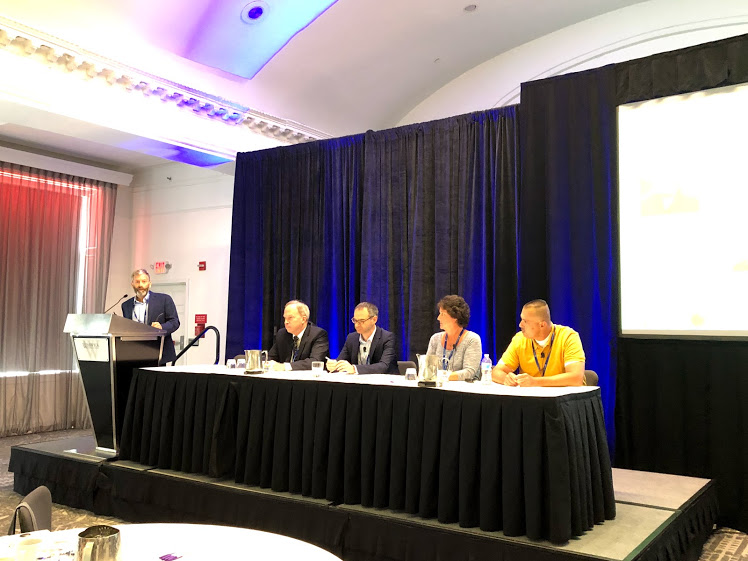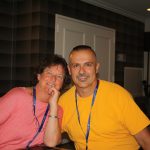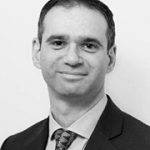All About Clinical Trials

Ben Shaberman (far left), Senior Director of Scientific Outreach and Community Engagement for Foundation Fighting Blindness moderates a four-member panel discussion in a session called “All About Clinical Trials” at the LCA Family Conference in July in Philadelphia.
Clinical trials are never done in a vacuum, or in a medieval basement where Dr. Frederick Frankenstein (pronounced Fronkensteen), his pretty lab assistant, Inga, and faithful houseboy, Igor, create a monster.
While the creature from the 1974 movie “Young Frankenstein” turns out to be somewhat civilized, (see Gene Wilder as the young doctor and Peter Boyle as the monster doing the soft-shoe in white tie and black tails to “Puttin’ on the Ritz”), a caption above that lab team in a slide shown at the Sofia Sees Hope second LCA Family Conference cautions: “Regulatory Oversight is Critical!”
Humor credit goes to Ben Shaberman, senior director of scientific outreach and community engagement for Foundation Fighting Blindness. He moderated a four-member panel discussion in a session called “All About Clinical Trials” at the July conference in Philadelphia. Shaberman reports on retinal research for the Foundation’s print and electronic publications. He also presents scientific advancements at local and national events and enjoys working with constituents to help them understand their retinal disease and current research that may benefit them.
Making sure trials are safe
Panelist Dr. Wiley A. Chambers, the U.S. Food and Drug Administration’s Supervisory Medical Officer in the Office of New Drugs, said terrible outcomes can happen in trials not approved and regulated by the FDA.
Dr. Chambers previously cited a disastrous case in which a 77-year-old woman traveled to an alleged clinic to have “stem cells” injected in her eyes in the hope of a cure or at least help for her macular degeneration. The procedure entailed separating “stem cells” from the woman’s belly fat and injecting them into her eyes to supposedly regenerate tissue. Not covered by insurance and not federally regulated, the procedure cost almost $9,000 and caused her vision to badly deteriorate after her retinas peeled away from her eyes.
The FDA assigns an Investigational New Drug (IND) number to every legitimate clinical trial.
“Just be careful when you go to a clinical trial or a physician that it is a legitimate trial,” Dr. Chambers said. “If they can’t give you an IND number, then walk away.”
The website Clinicaltrials.gov includes trials that do have an IND number and unregulated trials that do not have an IND number. Avoid them. One must specifically ask if they have been issued an IND number, signaling the federal OK to proceed with clinical studies that happen in three phases.
Dr. Chambers also noted that trials are not for the benefit of participating patients. At the heart of a clinical trial is that researchers do not know what’s going to happen. A key word here is equipoise – a balance or counterbalance – of something.
“We do the clinical trial and find out, does this have some efficacy and is it safe?”
Clinical trials tell as much information as possible, balanced with a doable study and doable patient commitment.
“It’s a balancing act,” he said. “The trials are to help inform people afterward.”
A long, expensive process
Research studies in humans are for potential therapies; they take 10 years or more to complete and can cost tens or hundreds of millions of dollars.
It took 12 years and $500 million to research and develop LUXTURNA™, an engineered virus delivered by subretinal injections of the human RPE65 gene, a gene that, when mutated, causes a form of LCA called LCA2 (RPE65-LCA).
Panel members Tami Morehouse and her husband, Michael, experienced firsthand what it feels like to take part in a Phase 1/2 LCA/RPE65 gene therapy trial. Intervention at earlier ages can offer better results with degenerative diseases like LCA and other inherited retinal diseases (IRDs) because photoreceptors diminish with age.
The Cleveland-area couple talked about Tami’s pioneering experience as the oldest person, at 44, to take part in the LUXTURNA trial and regain some vision.
“It’s a huge, life-changing event for us,” Michael said.
Walking in Philadelphia three days after her first injection, Tami asked her husband if a building up ahead had stripes on it. Turns out, it was a parking garage with spaces between levels appearing as solid stripes. Before the injection, she could not see any part of the parking deck; her ability to discern solids and stripes meant the treatment already began improving her vision.
Tami had some vision in college and walked across the graduation stage by herself. Michael described her progressive vision loss as, “Go on, go on, big drop; go on, go on, big drop; no diagnosis.
“She was on a path to darkness and she knew it,” he said.
Taking the risk for the reward
He heard Jean Bennett, MD, PhD, on a Sunday radio show talking about her retinal research on the emerging therapy that came to fruition as LUXTURNA. He called her office early the next day, and said to the audience, “Guess who answered the phone?” (Here’s a link to a story on Dr. Bennett’s presentation at this conference.)
Seven months later they received an email from Dr. Bennett, with the subject line: “Are you ready?”
Dr. Bennett conducted the studies with her partner in research and in marriage, Dr. Albert M. Maguire.
In answer to a question about what she was thinking before beginning the trial, Tami said, “I don’t want to go totally blind.”
“In all honesty, I never thought that I’d ever have a shot at seeing … I kind of underestimated my possibilities. I became a much more functional person in day-to-day living. I would see who’s approaching. See my kids, my (softball-playing) daughter dancing off third base, taunting her catcher.
“I got way more than I anticipated.”
Tami is part of the Sofia Sees Hope Family Connections program, calming fears and sharing her experiences with many patients along the way, including very young ones.
“Even though huge strides have been made in clinical trials, they’re very frightened, they’re very nervous.
“Jean and Albert explained so much; they relieved my fears in such a way that I’ve been able to transmit that to families, to moms. It’s a lot of pressure for some moms.
“Just being able to say that it won’t hurt when Dr. Maguire inserts a needle in your eye because you’re out like a light; that is a beautiful thing because you don’t even know what’s happening to you.”
Tami advised potential surgical patients and their parents that even though undergoing surgery has the potential to do such good by improving vision, they should think about their expectations. “We are comfortable in our own zone; give us a little bit of change and it can throw us off.”
“If mom and dad or older siblings are calmer, the children are going to be more comfortable, too.”
Setting realistic expectations
Panelist Dr. Michel Michaelides, a founding member and head of clinical ophthalmology at MeiraGTx based in New York City and London, said clinical trials impact the daily lives of study participants because they’re required to undergo multiple tests, many of which, he said, are boring and tedious.
“We spend a lot of time letting people know what they’re really in for.”
Dr. Michaelides is the Principal Investigator of four interventional clinical trials and has 10 ongoing ethically approved studies. He is Professor of Ophthalmology at London’s UCL Institute of Ophthalmology in the Department of Genetics and Molecular Therapy, and Consultant Ophthalmologist at Moorfields Eye Hospital in the Departments of Inherited Eye Disease, Medical Retina and Pedriatric Ophthalmology.
Moderator Shaberman asked him what he says about therapy options to people who have lost a lot of vision. In advanced cases of vision loss, Dr. Michaelides said, optogenetics might be a relevant course of action. Optogenetics is the science of making cells in the retina that do not normally detect light, become light sensitive, and thereby aim to replace the lost light-sensitive cells (rods and cones/photoreceptors).
“The idea is to make cells that are not light sensitive, (be) light sensitive.”
Another course is retinal implant technology, also known as the “Bionic Eye” or “Artificial Vision,” in which doctors insert a light-sensitive microchip into the retina to provide a way to detect light. These implants can be placed on the surface of the retina (epi-retinal implants) or underneath the retina (sub-retinal implants). He also suggested the use of internal or external cameras with these implants, saying, “I think there’s going to be greater development in that area.”
Another avenue is stem cell therapies (cell therapies), in which donor cells could be used to grow fresh retinal cells for transplantation into the eye to replace lost cells.
He also is involved in the development of therapies using stem cells to replace lost light-detecting retinal cells. He has been Principal Investigator of the first ocular stem cell therapy trial, which involved transplanting retinal pigment epithelial cells (non-light-detecting cells) in patients with advanced Stargardt Disease.
His clinical trial for a potential LCA4 (AIPL1-LCA) therapy currently is recruiting participants.
Dr. Michaelides’ ocular research comprises 300 peer-reviewed publications and 25 book chapters. One of those research papers came into focus at the LCA conference in July, where an audience member – a mother of a child with LCA2 (RPE65-LCA) – told her story.
“Even after an ERG (electroretinography),*” she said, “nobody told us it was LCA.”
She said reading one of his research publications on RPE65 put her family on the right track.
“That’s what we took to our doctor,” she said. “So, you’ve been really important to our journey.”



